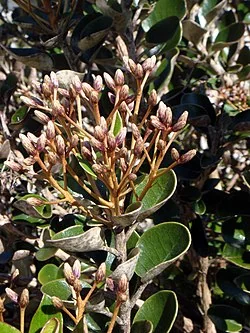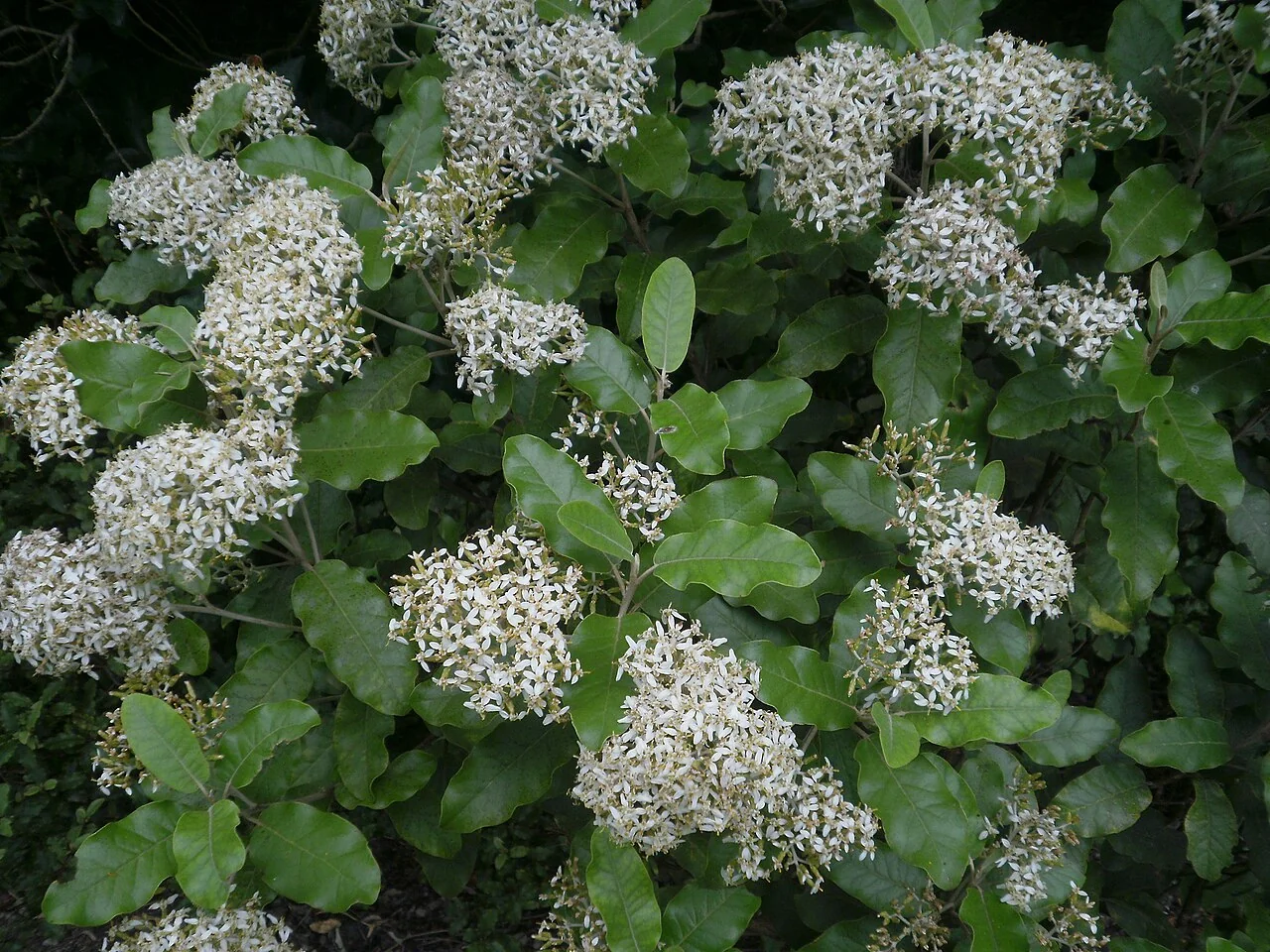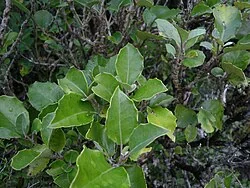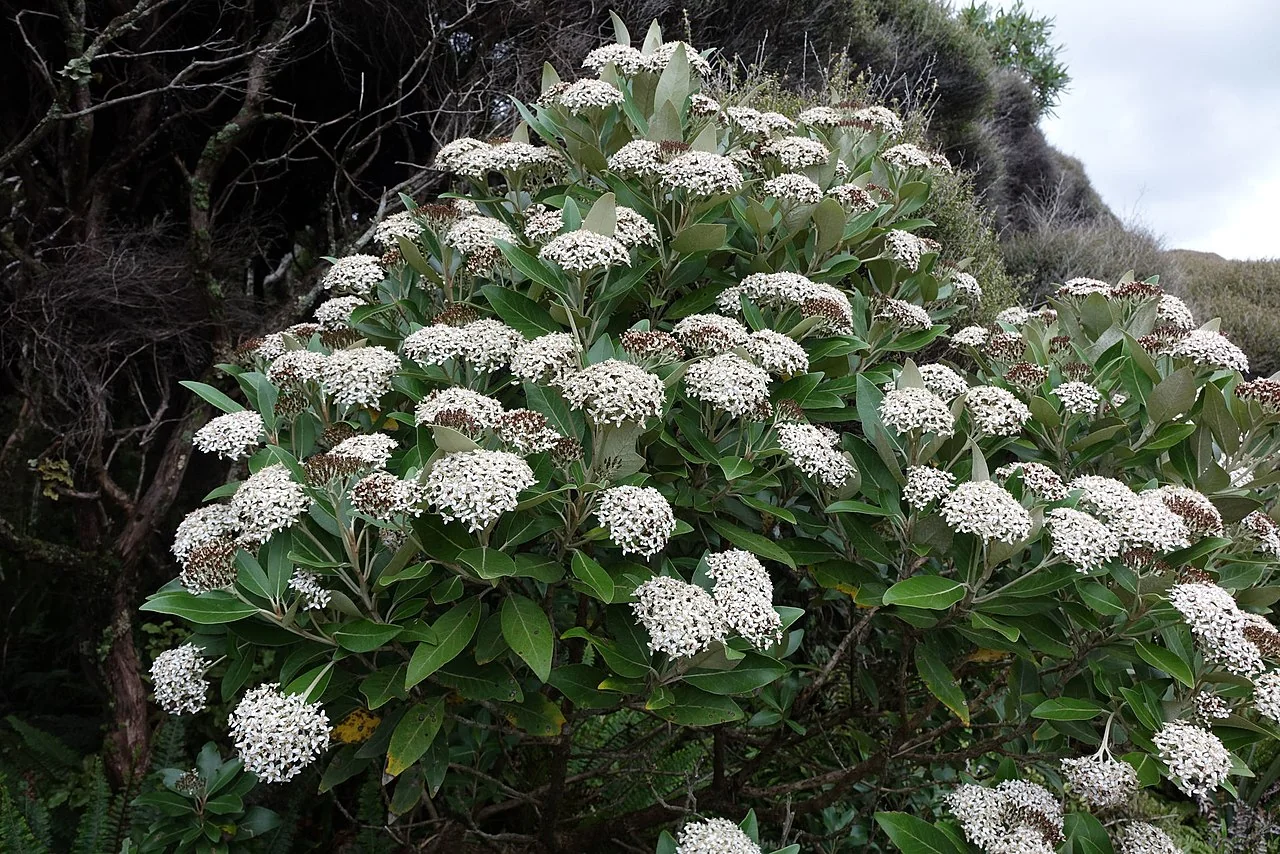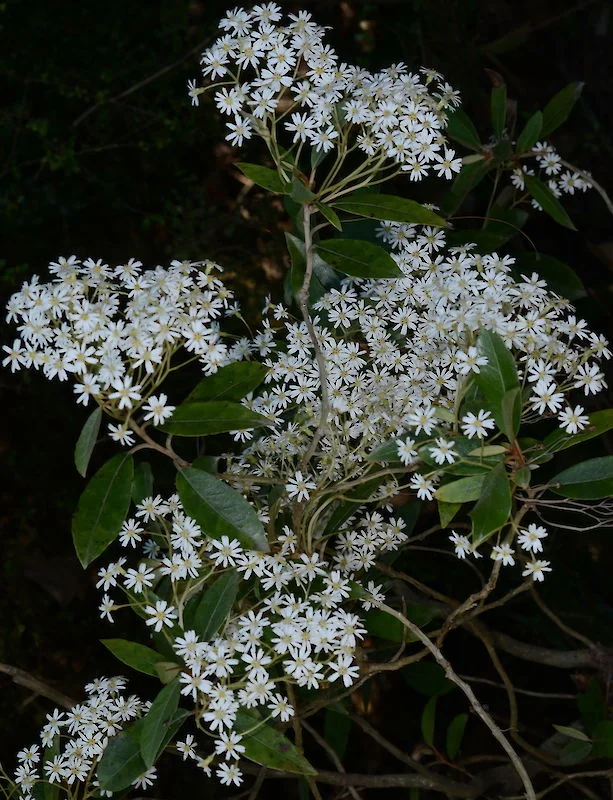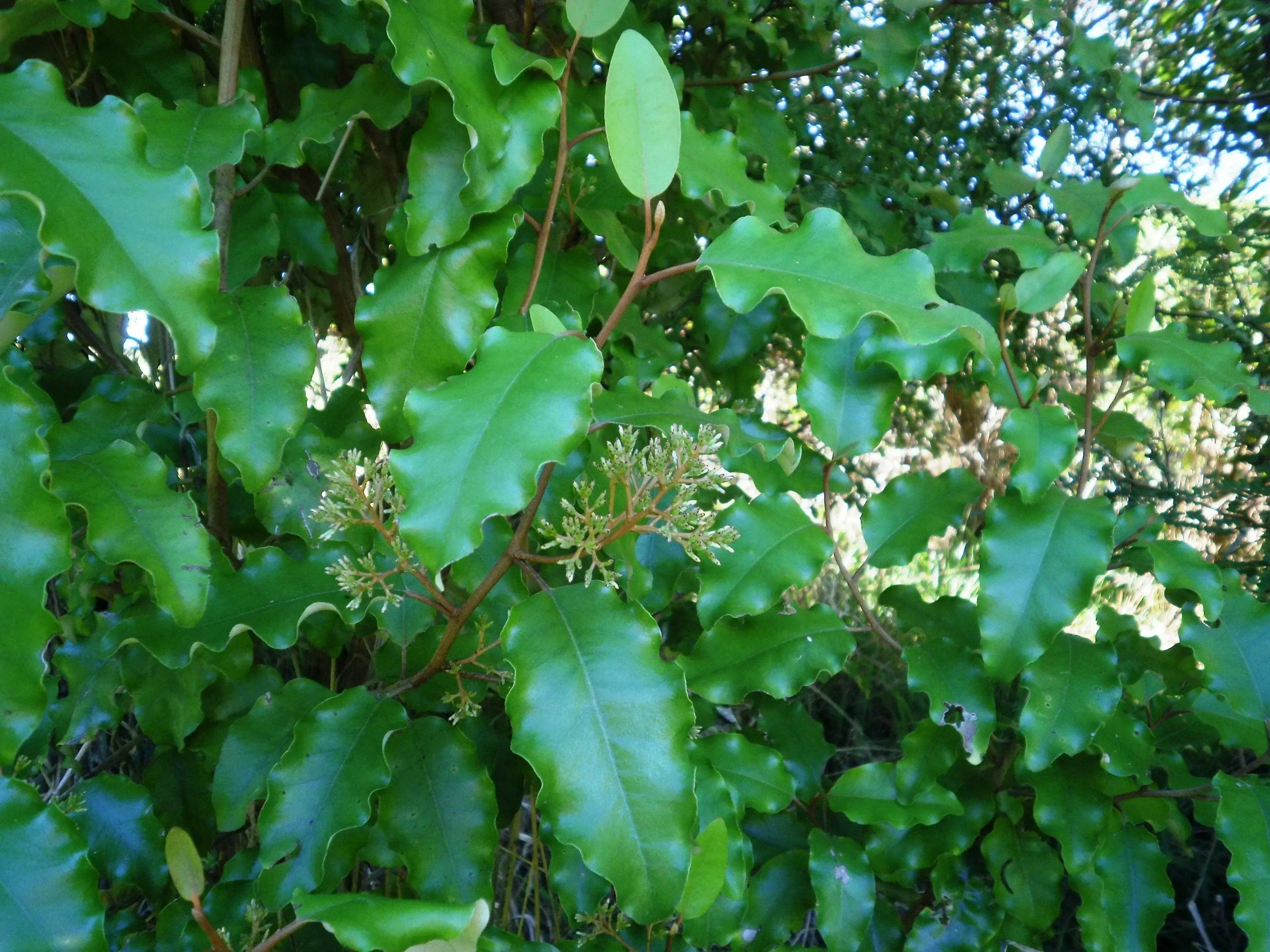
Coastal Tree Daisy
Olearia solandri
Coastal Tree Daisy (scientific name: Olearia solandri ) Coastal Tree Daisy is a native tree daisy that produces masses of small white or cream flowers. Like other Olearia species, it's valued for its hardy nature and ability to provide shelter and nectar for native wildlife. Explore more in the native plants index .

Plant Description
Botanical Features
Coastal Akeake and Whenua
Coastal tree daisy ( Olearia solandri ) forms tight, wind‑shorn domes on exposed headlands. Though formal rongoā references are scarce, its hardy, salt‑tolerant form embodies coastal whakatipu (growth) and shelter. Iwi and community plantings use O. solandri as a living wind‑filter and to stabilise friable cliff edges; in mixed plantings it protects less hardy taonga and supports pollinators across long, maritime flowering windows.
Coastal Tree Daisy ( Olearia solandri ), also known as Solander's Tree Daisy, is an evergreen shrub or small tree native to New Zealand, particularly the North Island and northern parts of the South Island. It has an upright, bushy stature with square, yellow, sticky twigs and can grow up to 4 meters high. It is prized for its fine, silvery-grey foliage, which consists of small, narrow leaves (5-10 mm long) with a soft, felted texture and a downturned margin that are white underneath. In spring and summer, it produces delicate, small, white daisy-like flowers that attract pollinators. It is well-suited for coastal environments due to its tolerance of salt spray and wind. It thrives in fertile, well-drained soil in full sun and can handle chalky soils.
Quick Facts
Overview
| Scientific Name | Olearia Solandri |
|---|---|
| Height | 2-6 m |
| Spread | 2-4 m |
| Water Needs | Low to moderate |
| Light | Full sun to partial shade |
| Frost Tolerance | Moderate to good |
| Salt Tolerance | Moderate |
| Growth Rate | Moderate |
| Lifespan | Long-lived |
Climate Best Suited to
Regional climate suitability across major New Zealand cities.
Regional Suitability
| Whangārei | Ideal |
| Auckland | Ideal |
| Hamilton | Suitable |
| Rotorua | Suitable |
| Tauranga | Ideal |
| Gisborne | Ideal |
| New Plymouth | Ideal |
| Whanganui | Ideal |
| Palmerston North | Suitable |
| Napier | Ideal |
| Wellington | Ideal |
| Nelson | Ideal |
| Christchurch | Suitable |
| Dunedin | Suitable |
| Invercargill | Suitable |
| City | Climate Suitability |
|---|
Natural Habitat
Coastal Tree Daisy is endemic to New Zealand, found in the North Island and the northern parts of the South Island. This species primarily inhabits coastal areas, thriving in dry, exposed conditions. It is highly resistant to maritime exposure, wind, and salt spray, and can tolerate free-draining soils. While predominantly coastal, it can occasionally be found inland or in estuary swamps. It prefers full sun to partial shade.
Plant Conservation
Conservation
Olearia solandri , also known as the coastal tree daisy or Solander's tree daisy, is an evergreen shrub or small tree native to New Zealand. It is prized for its silvery-grey foliage and delicate white daisy-like flowers, making it suitable for coastal gardens, windbreaks, and native plantings due to its tolerance to salt spray and wind. This species plays an important role in stabilizing coastal environments and provides nectar for native pollinators. While the NZPCN lists "Current conservation status" as a category for Olearia solandri , a specific current conservation category is not stated here. However, its ecological value and hardiness suggest it is a significant species for coastal ecosystem restoration.
Growing Requirements
Soil Requirements
Coastal shrub preferring sandy or light loams with excellent drainage; tolerates Salt and Wind when established.
Light Requirements
Full sun for best flowering and dense habit; light shade tolerated.
Water Requirements
Low-moderate after establishment; regular watering during first summers.
Planting Guide
1. Planting Location and Soil:
- Sunlight: Plant in full sun.
- Soil: Requires fertile, well-drained soil. It thrives in chalky soils but can also grow in light loam or peaty soil. It tolerates a range of soil types including light (sandy), medium (loamy), and heavy (clay) soils, and prefers well-drained conditions.
- Exposure: Olearia solandri is highly tolerant of maritime exposure, making it an excellent choice for coastal gardens. It benefits from shelter from cold, drying winds, especially in areas with warm winters.
2. Watering:
- Water regularly when the plant is young.
- Once established, it is drought-tolerant, but consistent moisture levels are beneficial as it's an evergreen. Typically, watering once every 1-2 weeks is sufficient for established plants.
Ecological Role
Olearia solandri serves as a cornerstone species in New Zealand's coastal ecosystems, providing essential ecological services that support marine and terrestrial biodiversity. This hardy evergreen shrub plays a crucial role in stabilizing fragile coastal environments while creating vital habitat corridors that connect different ecosystem zones along the country's extensive coastline.
Coastal Ecosystem Foundation
- Habitat creation and protection: Dense, tangled branching provides excellent shelter and nesting sites for coastal birds, while the robust structure creates windbreaks that protect smaller plants and fauna from salt spray and strong coastal winds.
- Soil stabilization specialist: Extensive root systems bind coastal soils and prevent erosion on dunes, cliffs, and shoreline areas, while contributing organic matter through leaf drop that improves soil structure and fertility in challenging coastal conditions.
- Salt spray filtration: Leathery, moisture-conserving leaves act as natural barriers that filter salt from coastal winds, creating protective microclimates that enable other less salt-tolerant plants to establish and flourish behind the coastal tree daisy.
- Succession facilitation: Pioneer species characteristics allow it to colonize disturbed coastal sites, creating conditions that enable other native species to establish and develop into more complex plant communities over time.
Pollination and Wildlife Support
- Pollinator biodiversity hotspot: Delicate white daisy-like flowers attract diverse range of pollinators including native bees, flies, butterflies, and moths, making it a crucial nectar source during late spring to summer flowering periods when many coastal plants bloom.
- Bird habitat excellence: Hardy branching structure and dense foliage provide excellent shelter for small coastal birds, offering protection from predators and harsh weather while creating ideal nesting environments in exposed seaside locations.
- Seed dispersal network: Wind and water-dispersed seeds enable natural colonization of new coastal areas, while bird visitors help spread seeds to suitable locations, enhancing genetic diversity and population resilience.
- Invertebrate sanctuary: Complex branching structure creates numerous microhabitats for beneficial insects, spiders, and other invertebrates that form essential food webs supporting larger wildlife populations.
Marine-Terrestrial Interface Functions
- Coastal buffer zone creation: Positioned along coastlines, it creates essential buffer zones between marine and terrestrial environments, moderating the impact of storms, king tides, and saltwater intrusion on inland vegetation.
- Nutrient cycling enhancement: Captures and processes salt-laden nutrients from marine environments, converting them into forms available to terrestrial plant communities while filtering excess salts that could damage inland vegetation.
- Climate resilience support: Adaptation to variable coastal conditions including wind, salt exposure, and moisture fluctuations provides stability during climate extremes, maintaining ecosystem function when other species may struggle.
- Connectivity corridor maintenance: Links fragmented coastal habitats, enabling wildlife movement and genetic exchange between isolated populations of coastal species along New Zealand's extensive shoreline.
Conservation Ecosystem Services
- Biodiversity protection: Critical component of coastal ecosystems that supports both common and threatened species, providing habitat for specialized coastal fauna that depend on stable saltwater-terrestrial transition zones.
- Natural restoration catalyst: Ability to establish on degraded coastal sites makes it valuable for natural regeneration projects, kick-starting ecological restoration in areas damaged by human activities or natural disasters.
- Climate change adaptation: Tolerance for variable conditions and ability to stabilize coastal environments provides important ecosystem resilience against sea level rise, increased storm intensity, and changing precipitation patterns.
- Educational value: Serves as an excellent example of coastal adaptation strategies, demonstrating how native plants have evolved specialized characteristics to thrive in challenging marine-influenced environments.
Through its multiple ecological functions, O. solandri demonstrates the critical importance of native coastal vegetation in maintaining the health and resilience of New Zealand's unique marine-terrestrial ecosystems.
Uses and Significance
Coastal Restoration and Conservation
Olearia solandri is critically important for coastal restoration projects throughout the North Island and northern South Island, where its At Risk-Declining status makes cultivation and planting essential for species recovery. This fast-growing shelter and hedging plant excels in dry, exposed coastal sites, stabilizing coastal ecosystems and maintaining biodiversity. Named after Daniel Solander, one of the first botanists to study New Zealand flora during Cook's voyages, this species represents an important piece of New Zealand's botanical heritage requiring active conservation efforts.
Practical Applications and Ecological Value
The distinctive square yellow sticky twigs and dense growth habit make this species ideal for coastal hedging and windbreaks in challenging seaside environments. Its tolerance for chalky soils and exceptional coastal exposure handling capabilities provide essential habitat stabilization where few other plants survive. The white autumn flowers offer crucial pollinator support in coastal ecosystems, while the robust growth pattern helps prevent coastal erosion, making it doubly valuable for both conservation and practical landscape applications.
Cultural Significance
Cultural Importance
Coastal Heritage
Collected by Banks and Solander, coastal tree daisy carries historic and botanical significance; planting it in coastal restorations showcases native wind- and salt-tolerant shrublands.
Olearia solandri , also known as coastal tree daisy or Solander's tree daisy, holds cultural significance primarily through its ecological role and its connection to New Zealand's natural heritage. It is an evergreen shrub or small tree endemic to New Zealand, found in coastal areas of the North Island and the northern parts of the South Island. It is important for coastal ecosystem restoration, providing shelter and nectar for native insects and birds. Its hardiness, tolerance to salt spray and wind, and ability to thrive in well-drained coastal soils make it ideal for stabilizing coastal environments and for use in windbreaks and native plantings. The plant is known by the Māori name "takupurenga." Olearia solandri was among the first 350 species collected by botanists Joseph Banks and Daniel Solander during Captain James Cook's first voyage, and the species was named after Daniel Solander. While it has significant ecological value and a recognized Māori name, specific traditional edible or medicinal uses by Māori have not been widely documented in standard references.
Landscaping Ideas
Coastal Tree Daisy ( Olearia solandri ) is an exceptional choice for landscaping projects that require both functional performance and aesthetic appeal in challenging coastal environments. This fast-growing, wind-hardy shrub combines remarkable salt tolerance with attractive seasonal displays, making it one of New Zealand's most valuable plants for seaside gardens and exposed locations where many other species struggle to establish and thrive.
Coastal Garden Foundations
- Premier windbreak establishment: Dense, robust growth to 4 meters tall and 2 meters wide creates excellent windbreaks that protect entire garden areas from salt-laden coastal winds, enabling more tender plants to establish and flourish in the shelter provided.
- Erosion control specialist: Extensive root systems make it invaluable for stabilizing coastal banks, dunes, and slopes where soil erosion is a constant threat, while the dense growth provides natural barriers against storm damage and saltwater intrusion.
- Salt spray filtering: Natural adaptation to coastal conditions enables it to filter and absorb salt from coastal winds, creating protected microclimates that significantly expand the range of plants that can be grown in exposed seaside locations.
- Structural backbone planting: Provides essential framework for coastal gardens, establishing reliable evergreen structure that enables gardeners to build layered plantings with more delicate species in the protected areas behind the coastal tree daisy barriers.
Formal Landscape Applications
- Exceptional hedging performance: Responds beautifully to regular pruning, creating dense, neat hedges when plants are spaced 1-1.5 meters apart, perfect for formal boundaries, property definition, and creating garden rooms in coastal environments.
- Screening and privacy solutions: Fast growth rate and dense form make it excellent for creating effective screens that provide year-round privacy while withstanding coastal conditions that damage other screening plants.
- Mixed border backbone: Serves as an excellent foundation plant in mixed native plantings, providing reliable evergreen structure while the seasonal white flowers and attractive foliage complement other coastal natives throughout the year.
- Feature specimen displays: Individual plants create striking focal points with their naturally attractive shape, seasonal vanilla-scented flowers, and distinctive two-toned foliage that provides year-round visual interest in landscape compositions.
Coastal Restoration and Conservation Landscaping
- Pioneer restoration plantings: Outstanding ability to establish on degraded coastal sites makes it perfect for kick-starting restoration projects in areas damaged by storms, development, or natural erosion processes.
- Native ecosystem recreation: Essential component for authentic coastal landscape recreation, providing habitat structure that supports native birds, insects, and other wildlife while maintaining genetic continuity with natural coastal forests.
- Climate resilience planning: Tolerance for extreme weather events and changing coastal conditions makes it valuable for future-proofing landscape investments against sea level rise and increasing storm intensity.
- Biodiversity enhancement: Attracts and supports diverse wildlife populations including pollinators, birds, and beneficial insects, creating dynamic ecosystem functions within cultivated landscape settings.
Low-Maintenance Garden Solutions
- Water-wise coastal gardening: Once established, excellent drought tolerance eliminates the need for supplemental irrigation even in challenging sandy coastal soils, making it ideal for sustainable landscape design.
- Minimal care requirements: Requires only annual pruning to maintain desired shape, making it perfect for large-scale coastal developments, holiday homes, and areas where ongoing maintenance access is limited.
- Adaptable soil tolerance: Thrives in poor, sandy, chalky, or dry soils typical of coastal areas, reducing the need for soil amendment and enabling successful landscaping in locations where soil improvement is impractical.
- Year-round performance: Evergreen nature provides consistent landscape structure throughout all seasons, while late summer flowering adds seasonal highlights without requiring seasonal replanting or intensive management.
Design Integration and Spacing
- Strategic placement recommendations: Position in front lines of coastal gardens to create protective barriers, with spacing of 1-1.5 meters for hedging applications and 1.5-2 meters for mixed plantings to accommodate natural spread.
- Layered planting systems: Use as protective backdrop for creating graduated plant communities, starting with coastal tree daisy windbreaks and progressing to mid-level shrubs and finally delicate perennials in the most protected areas.
- Seasonal interest maximization: Plant in clusters to create stunning late summer displays of vanilla-scented white flowers that mimic natural coastal landscapes while providing concentrated pollinator resources.
- Companion planting opportunities: Combines beautifully with other salt-tolerant natives including Coprosma species, Hebe varieties, and coastal grasses to create diverse, resilient plant communities that support local wildlife.
Coastal Challenge Solutions
- Extreme exposure tolerance: Thrives in full coastal exposure where salt spray, strong winds, and poor soils create impossible conditions for most other plants, opening up previously unusable coastal areas for successful landscaping.
- Storm recovery assistance: Fast growth and resilient nature enable quick recovery from storm damage, maintaining landscape function and structure even after severe weather events that devastate other coastal plantings.
- Sand dune stabilization: Particularly valuable for dune restoration and stabilization projects where its deep roots and dense growth help prevent sand movement while creating habitat for dune-dwelling wildlife.
- Marine environment transitions: Creates essential buffer zones between marine and terrestrial environments, enabling successful garden establishment in close proximity to beaches, estuaries, and salt marshes.
Seasonal Care Calendar
Spring
Plant; tip-prune to shape.
Summer
Water in dry spells; light trim post-flowering.
Autumn
Mulch; corrective tidy.
Winter
Minimal inputs; ensure drainage.
Pruning and Maintenance
Techniques and Timing
Coastal tree daisy clips exceptionally well for hedge formation and coastal screening, with its characteristic square sticky twigs responding beautifully to regular maintenance. The fast-growing nature means light, frequent clipping maintains dense coastal shelter more effectively than heavy renovation cuts. Given its At Risk-Declining conservation status, careful pruning practices help preserve the species while maintaining its practical value for coastal protection. Avoid cutting back to bare wood as the sticky young growth provides the plant's distinctive characteristics and vigorous recovery ability essential for coastal stabilization projects.
How to Grow Coastal Tree Daisy
Coastal Tree Daisy is an "At Risk - Declining" native shrub perfect for coastal conditions with fragrant autumn flowers. This fast-growing shelter and hedging plant excels in dry, exposed coastal sites, stabilizing coastal ecosystems and maintaining biodiversity. Named after Daniel Solander, one of the first botanists to study New Zealand flora during Cook's voyages, this species represents an important piece of New Zealand's botanical heritage requiring active conservation efforts. Understanding its propagation methods is key to successfully growing this unique species.
From Cuttings
Semi-hardwood cuttings from the distinctive square sticky twigs root well when treated with rooting hormone and maintained under consistent humidity. The sticky young stems characteristic of this species provide excellent cutting material that preserves the parent plant's coastal tolerance. Given the "At Risk - Declining" status, successful cutting propagation is essential for conservation efforts and coastal restoration projects where this hardy species provides critical habitat stabilization. Take cuttings in late summer or early autumn from healthy, non-flowering shoots. Maintain consistent moisture and warmth until roots develop, typically within 6-8 weeks.
From Seed
Propagating Coastal Tree Daisy from seed is a viable method, though it requires fresh seeds and careful attention to conditions. Fresh seed from the white autumn flowers should be surface-sown on well-draining coastal mix and kept evenly moist. Conservation propagation from seed helps maintain genetic diversity crucial for this "At Risk - Declining" species that once was among the first 350 species collected by Joseph Banks and Daniel Solander during Cook's first voyage. Successful seed propagation supports both species recovery and coastal restoration programs where Olearia solandri provides essential erosion control and wildlife habitat throughout its North Island and northern South Island range.
Pests and Diseases
Coastal Tree Daisy ( Olearia solandri ) exhibits remarkable resistance to pests and diseases, a characteristic that stems from its natural adaptation to harsh coastal environments where constant exposure to salt spray, wind, and challenging growing conditions has resulted in a plant with exceptional natural defenses. This hardy nature makes it one of the most reliable and low-maintenance native shrubs for challenging coastal landscapes.
Natural Disease Resistance
- Exceptional coastal hardiness: Natural adaptation to extreme coastal conditions including salt spray, strong winds, and poor soils has resulted in a plant with robust immunity to most common garden pests and diseases that typically affect less hardy species.
- Environmental stress tolerance: Superior tolerance for drought, wind, and salt exposure means the plant maintains vigor during challenging conditions, avoiding the stress-related weakness that often makes plants susceptible to pest and disease problems.
- Dense foliage protection: Small, leathery leaves with protective waxy coatings provide natural barriers against many pest insects while the dense branching structure offers physical protection from environmental damage.
- Rapid recovery ability: Fast growth rate and vigorous nature enable quick recovery from any minor damage caused by environmental stresses or occasional pest activity, maintaining overall plant health and appearance.
Preventive Cultural Practices
- Optimal drainage importance: The single most critical factor for maintaining healthy coastal tree daisy is ensuring excellent drainage, as waterlogged conditions represent the primary threat to plant health and can predispose plants to root rot in heavy soils.
- Appropriate site selection: Plant in full sun locations with good air circulation, avoiding low-lying areas prone to water accumulation or poorly-ventilated spots that might encourage humidity-related issues during periods of high moisture.
- Proper plant spacing: Allow adequate spacing between plants (1-1.5 meters for hedging, 1.5-2 meters for specimens) to ensure excellent air circulation and prevent overcrowding that could create conditions favorable for pest development.
- Mulching benefits: Apply organic mulch to maintain consistent soil moisture and suppress competing weeds, while avoiding thick mulch layers that might retain excessive moisture around the plant base.
Occasional Minor Issues
- Aphids on new growth: Rarely, small populations of aphids may appear on soft new growth during spring, particularly during periods of lush growth following favorable weather. Monitor regularly and treat with insecticidal soap if populations become problematic.
- Environmental stress symptoms: Overwatering in poorly-drained locations can cause yellowing leaves and reduced vigor, while prolonged drought stress in very sandy soils may cause leaf browning and temporary growth slowdown.
- Scale insects occasional occurrence: Very rarely, minor scale insect infestations may occur, appearing as small bumps on stems. These are easily controlled with horticultural oil applications if detected early during regular plant inspections.
- Wind damage in extreme events: While generally wind-resistant, extreme storm events may cause mechanical damage to branches, though the plant's robust nature enables rapid recovery with minimal intervention required.
Integrated Management Approach
- Regular monitoring routine: Check plants during routine garden maintenance for any signs of stress or pest activity, focusing on new growth areas where problems are most likely to first appear during active growing seasons.
- Water management strategy: Maintain consistent but not excessive watering during establishment, then rely on natural rainfall once plants are established, avoiding overwatering that can weaken natural defenses.
- Organic intervention methods: If minor pest issues occur, use organic control methods such as insecticidal soap, neem oil, or horticultural oils that won't harm beneficial insects attracted to the flowers and natural ecosystem functions.
- Stress reduction focus: The most effective pest and disease prevention strategy is maintaining optimal growing conditions through proper site selection, adequate drainage, and appropriate spacing to support natural plant vigor.
Coastal Environment Benefits
- Salt spray advantage: Natural tolerance for salt spray actually provides some pest deterrent effects, as many common garden pests cannot tolerate the saline conditions that coastal tree daisy thrives in.
- Wind dispersal benefits: Constant coastal winds help prevent pest buildup by physically disrupting insect populations and reducing humidity levels that favour fungal disease development.
- Beneficial insect attraction: Flowers attract beneficial insects including predatory species that help control any pest problems naturally, creating balanced ecosystem functions within the garden environment.
- Low maintenance advantage: Exceptional pest and disease resistance makes it ideal for coastal locations where regular garden maintenance may be difficult due to weather conditions or accessibility issues.
The outstanding pest and disease resistance of coastal tree daisy, combined with its ability to thrive in challenging coastal conditions, makes it an exceptional choice for low-maintenance coastal gardens where reliability and resilience are essential for long-term landscape success.
Bonus Tip
Expert Growing Advice
Coastal tree daisy ( Olearia solandri ) is naturally salt-hardy. In harsh shore winds, plant in staggered rows to create a permeable shelterbelt; filtered wind protects foliage better than a solid barrier and promotes even, upright growth.

